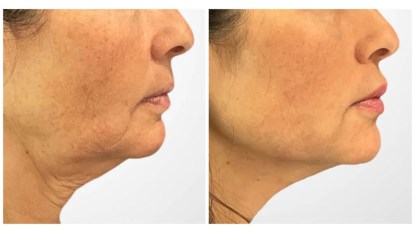4 Things to Consider Before Getting Fillers or Injections, According to Expert

If you’re over 40 and concerned about sagging skin, you might be wondering about fillers. These days, it seems everyone is getting them — a filler here, a filler there — even if they’re not admitting it.
Otherwise known as injectables, fillers are substances that are injected into the skin to smooth wrinkles and improve the skin’s appearance. You might have gone online to look up information, and read about Botox, Juvederm, Dysport, and other products. But what does each type of filler do? Are all fillers created equal? And which filler will work best for what you need?
I spoke to acclaimed plastic surgeon and Joel Beauty Medspa owner Dr. Nevin Elizabeth Golkalp to get her advice on the crucial questions to ask yourself and your doctor before you get fillers and injectables.
1. Identify your main cosmetic or skincare concern.
Skin care — from cleansers to BOTOX® to fillers to major plastic surgery — can be tricky, because as a group, women “of a certain age” all share similar skin concerns. Among these are wrinkles, crow’s feet, and loss of collagen, to name a few. But that’s usually where the similarities end.
Start by asking yourself what you want to fix. Do you want to reduce sagging by adding volume and overall lift? Are you looking for something that will get rid of the pesky lines between your brows? Dr. Gokalp insists that one of the most important things to consider is what you want the filler or injection to achieve.
In short, it’s all about the enhancements and improvements you want to see when you look in the mirror. Because while most fillers are hyluronic acid-based, they will all do different things. For example, Juvederm smooths skin while Sculptra lifts it. Deciding what you want your fillers and injections to do before you get them will help you and your treatment provider choose a treatment option that’s personalized to suit your needs.
2. Choose your doctor wisely.
Not all plastic surgeons and estheticians are created equal — at least when it comes to delivering results that look beautiful and natural. “Some injectors and treatment providers will just give you Botox whenever you want. I always wait at least six months between treatments,” she says.
Why? “Because if you get too much Botox too frequently, your body can develop a resistance to it,” she explains. “This is why it’s important to find a certified professional who is invested in the actual client over the profit.”
Simply put, the more experience your treatment provider has, the more capable they are of selecting the right filler for you and ensuring that your results are exactly what you want.
3. When it comes to filler choice, be open to professional feedback and experience.
“I always say, most 45 year-olds need [only a] little boost, unless they’ve been ill or there’s been dramatic weight loss,” notes Dr. Gokalp. She points out that when she first started practicing over 20 years ago, there were just two options for fillers. Now, of course, there are many more, and “they all do different things for different people, depending on body chemistry and physiological response.”
Dr. Gokalp says that most clients she sees want to look like themselves, only a bit better. Some think this requires major treatments or extensive surgery. She, however, says many corrections can be made with fillers. Her clients, of course, are always pleasantly surprised and delighted.
4. Remember what true beauty really is.
Dr. Gokalp insists that a delicate touch is the way to go when working with fillers and injectables. Her states philosophy: “Just enough.”
“My clients mostly want to enhance their natural beauty,” she says, “and that’s what I believe in.” She went on to explain that she started her Medspa just after 9/11, and told clients to render payment in three acts of kindness instead of cash. “That’s the way we spread love in the world, is through kindness.” And isn’t that what true beauty is all about?













